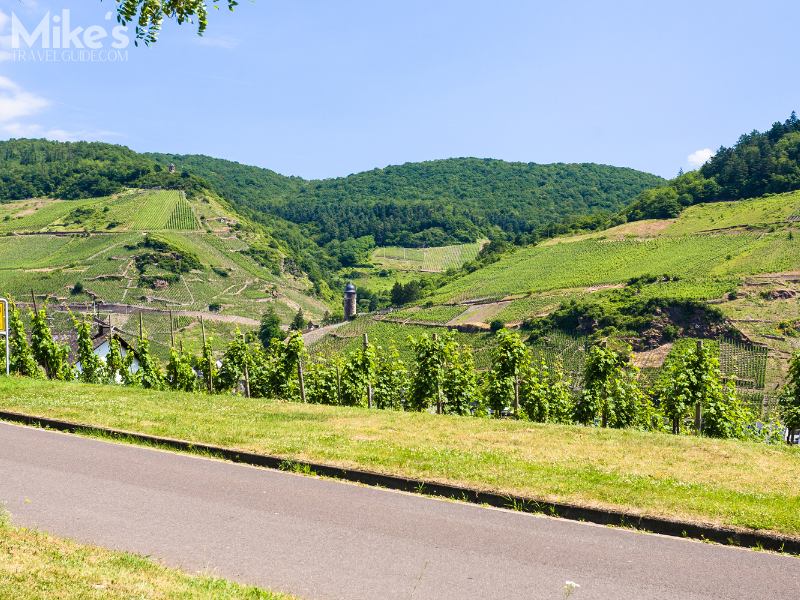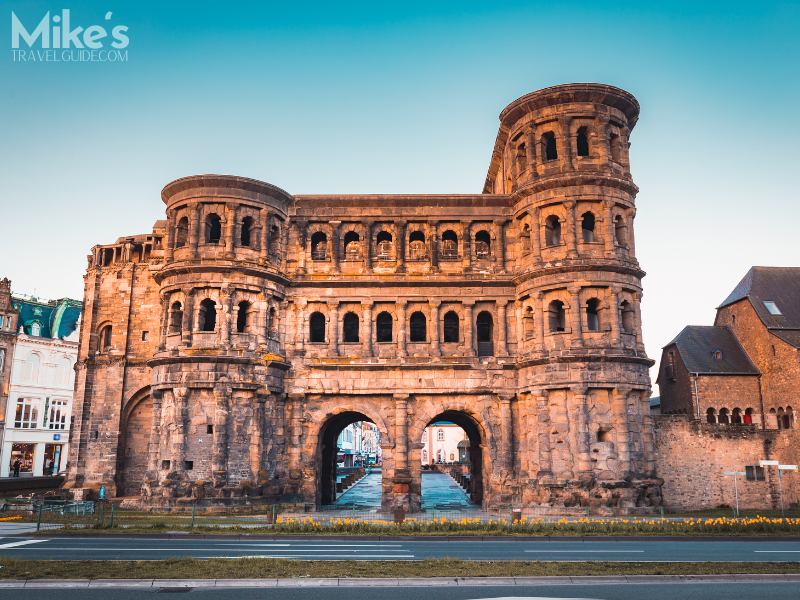One of Germany’s most enchanting journeys unfurls along the serpentine Mosel River, winding through a scenic valley cloaked in vine-draped slopes and adorned with storybook villages, mighty medieval castles, and historic riverside towns.
Among the countless routes that crisscross this storied land, the Mosel River Wine Road between Koblenz and Trier stands as a true gem, revealing the region’s layered tapestry of history, architecture, and winemaking traditions with each passing bend.
Embark on Your Mosel Adventure

To commence your Mosel meander, make your way to the charming riverside town of Winningen, situated a convenient 15 miles southwest of Koblenz. From the A61/E31 autobahn, follow the signs and take exit 38, guiding you toward the town’s center. Once there, seek out the B416 river road and turn right, embarking on your southwestern journey toward the ancient city of Trier.
As you gently cruise along the Mosel’s winding course, an array of captivating sights and stops beckon, each one a gateway to the region’s rich heritage and breathtaking natural splendor.
Highlights of the Mosel Wine Road
Niederburg Ruins – Perched above the quaint village of Kobern, the crumbling remnants of this 12th-century castle offer a haunting glimpse into the region’s medieval past, its weathered stones standing as silent sentinels over the verdant valley below.
Schloss von der Leyen – Formerly known as Schloss Gondorf, this moated ancestral castle of the noble House of Leyen is a true architectural gem, its imposing tower guarding a strategic bend in the river as you approach the municipality of Kobern-Gondorf.
Burg Thurant – Prepare to be awestruck by this massive hilltop fortification near Alken, a formidable relic of the late 12th century. Once divided between the powerful archbishoprics of Cologne and Trier, Burg Thurant’s guided tours transport visitors back through the mists of time, unveiling the secrets of its storied past.
Bischofstein – Across the river from Burgen, the 12th-century Bischofstein castle stands as a testament to the region’s enduring legacy, its origins potentially stretching back to the 5th and 6th centuries. Today, it serves as a residential school, its ancient walls sheltering a new generation of scholars.
Burg Eltz – No journey along the Mosel would be complete without a pilgrimage to this true fairy-tale castle, a breathtaking vision of turrets and towers nestled deep within the enchanting Eltz River valley near Müden and Moselkern. Owned by the same noble family for over eight centuries, Burg Eltz is an absolute must-see, a living embodiment of the region’s captivating history and legends.
As you continue your meandering path, be sure to pause in the charming riverside town of Cochem, its multi-turreted hilltop castle presiding over a tableau of half-timbered houses and winding cobblestone lanes. Further along, the “Sleeping Beauty of the Moselle,” Beilstein, casts its spell with its dreamy riverside setting and the medieval Burg Metternich looming above.
Near the hairpin bend of the river in Bremm, the skeletal ruins of Kloster Stuben, a 12th-century Augustinian monastery, appear to float upon an island, a haunting yet beautiful sight that encapsulates the region’s rich monastic heritage.
Discovering the Delights of Zell and Beyond
The delightful village of Zell makes an ideal base for exploring the Mosel, with its lively market square and the imposing Marienburg castle and former monastery just across the river. As you approach the ancient city of

, keep an eye out for the scattered remnants of Roman settlements, like the Villa Rustica in Mehring, recalling the region’s deep roots as a vital trade route in antiquity.
Other notable sights along the way include the 14th-century Grevenburg castle in Traben-Trarbach, left in ruins after French bombardment centuries ago, and the towering remnants of Landshut castle in Bernkastel-Kues, a potent symbol of the town’s enduring spirit despite the ravages of fire in the 17th century.
Enhancing Your Mosel Experience
To truly learn about the rich tapestry of the Mosel’s castles and fortifications, consider purchasing a copy of the insightful book “The Castles of the Moselle Between Coblenz and Trier” (around €3.50) at the Zell tourist information office. This indispensable guide will provide in-depth historical context and fascinating details, enriching your understanding and appreciation of these impressive medieval marvels.
As you explore, be prepared to pay modest admission fees for some of the castles and sites, typically ranging from €2.50 to €9 for an adult ticket. But the priceless memories forged while strolling through vine-cloaked villages, marveling at mighty medieval ruins, and discovering the Mosel’s countless treasures will linger far beyond the journey’s end.
